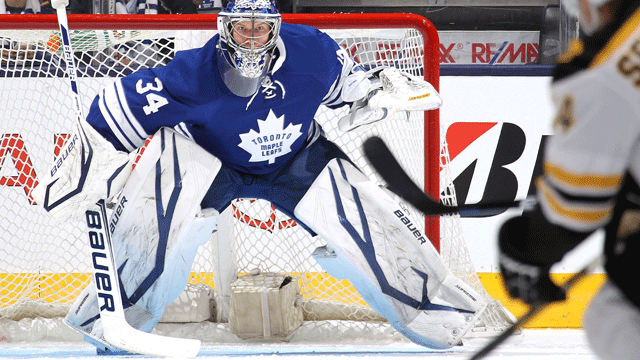If goaltender really is the loneliest position in hockey, you get the sense it’s by design. Companionship, it seems, just complicates the equation and people aren’t equipped to handle it. It creates conversations like the one that’s surrounded Canada’s most-watched team for much of the season, the same type that’s engulfed other burghs in this puck-possessed nation in recent years. It would be a lie to say coach Randy Carlyle deals with the chatter daily, because everyone who follows the Toronto Maple Leafs for a living knows by now there’s no point in asking. But that hasn’t stopped the omnipresent wondering.
Whether Jonathan Bernier or James Reimer should be the Leafs’ leading man has gone from being a simple starting lineup question to a riddle that’s picked apart as if the answer provides the secret to life. Different camps back a different guy for different reasons, the same way support groups sprung up in the argument around Roberto Luongo and Cory Schneider in Vancouver, and the Jaroslav Halak/Carey Price tandem in Montreal a few years back. But while those situations were created somewhat organically, what’s happening in Toronto is unique in that the Leafs elected to acquire another top young stopper when it seemed they already had one in their midst. That made sense to a portion of the fan base, while leaving another part incensed. Though Bernier’s early-season play relieved some of the steam, Leafs Nation is always one bad outing away from revisiting the referendum: Bernier or Reimer?
What makes the whole thing so delicious to delve into, of course, is the differences between the two puckstoppers. Bernier was born in the big city, Montreal, drafted 11th overall in 2006, ahead of every other goalie that year, and has always had the refined technique that makes informed observers take notice. Reimer hails from the tiny Manitoba town of Morweena, was taken 88 spots after Bernier in ’06 and has clawed his way from relative obscurity by visibly battling for every save. At his best, Bernier plays like a world-class orchestra, with every instrument perfectly on point. Vintage Reimer is more like a wailing guitar solo; even when the odd note gets missed, the sound can be inspiring.
Typically, the noise that surrounds these two stems from the fact people still believe that, to function best, a team needs a clear goaltending hierarchy. While we won’t completely dismiss that notion, the reality is, the landscape of NHL creases has changed thanks largely to how intensely schooled the position is now, and the vast improvements to equipment. “There are just a lot more very good goalies,” says former NHLer Brian Hayward, who’s now an analyst for the Anaheim Ducks. “There was a time when there was a significant difference between the No. 1 guy and the No. 2 guy in a lot of the markets. I don’t think that’s the case anymore.”
There’s also been a shift towards favouring competition over coddling. A perennial Vezina contender is always going to get more rope, but there’s now a prevailing sense that making two goalies earn their starts isn’t the worst thing in the world, even within the union itself. “(Most goalies) will tell you they can accept being the guy who’s not playing only so long as the other guy is playing really well,” says Hayward, who split time in Montreal with Patrick Roy in the late 1980s. “But as soon as his performance tails off, there’s an expectation that now it’s your turn. It’s that way with every other position, I don’t understand why the goaltending position is unique in that respect.”
While a meritocracy might be ideal for determining who plays, you get the sense that until it becomes undeniable one goalie is superior to the other, fans will find a justification to back their guy. The Bernier supporters say Reimer is too raw; he can’t catch puck and his rebounds are often out of control. Those who have faith in Reimer point to him saving the bacon of a Toronto team that’s been loose defensively, and note Bernier’s strong numbers in Los Angeles came while playing extremely limited minutes on a championship-calibre team. In a way, their contrasting resumés and form offer some kind of commentary on Bernier’s and Reimer’s respective devotees— as if they’re not just goalies, but Zodiac signs.
If you’re a Bernier, you believe in process and search for the logical solution to every problem. People sometimes ascribe a slight distance to your composed demeanor, but they’re overlooking the deep well of emotion within.
If you’re a Reimer, you’re a dreamer, someone who believes there’s no better story than that of the underdog. At times you’re scattered, but there’s a system to the mess and it makes sense to you. And after all, don’t flaws just make us human?
It will be interesting to see how the stars ultimately align in Toronto, and if there will be any parallels with what happened in Vancouver and Montreal. The Canucks and Canadiens both had a more traditional dynamics. In the case of Vancouver, a young goalie, Corey Schneider, simply developed to the point where he was able to overtake the veteran incumbent, Roberto Luongo. Then he got traded to New Jersey. As for the Habs, Halak and Price were two young goalies in the same organization drafted with different expectations—Price was a stud, Halak a long shot. But the Slovakian took the net over in 2010 with a playoff performance for the ages. Then he got traded to St. Louis.
Nothing of that nature feels imminent in Toronto, though who knows what happens if Bernier continues to stake his claim to the top job. All we can say for sure is, as long as there are two goalies on the scene, a chorus of supporters will always be warming up, waiting to sing their guy’s praises.

